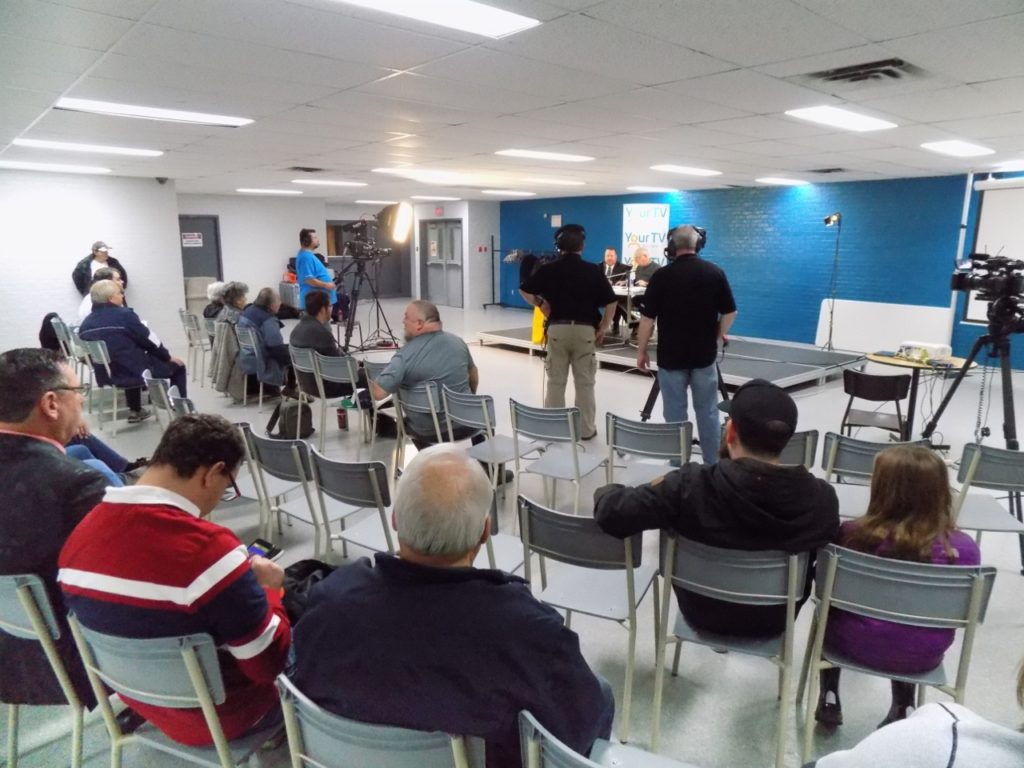Municipal elections across Ontario

Residents of Hawkesbury, Ontario gathered at the local community hall to find out municipal election results. Photo; James Morgan
Change and no change best describes the recent municipal elections in Ontario. On October 22, residents of the province’s 444 municipalities elected new councils.
In Ontario, all municipal elections are held on the same day, every four years. The voting systems are operated by municipal clerk’s offices. Unlike in the U.S., fewer municipal positions are elected in Canada. Only mayors, councilors, and school board members are elected by voters. Positions like local judges, coroners, and the highway superintendent are all appointed or hired.
The big race that even those in the far corners of the province always follow is Toronto. It’s the biggest city and the provincial capital, and it’s always a source of amusement and/or irritation for people who don’t live there. John Tory, with a last name fitting his moderate conservatism, was easily re-elected as mayor. He will be leading a much smaller council now because of Ontario Premier Doug Ford—a less moderate conservative, whose government passed legislation to reduce the size of the city council to 25 from 47 seats.
Ottawa and eastern Ontario
In Ottawa, Jim Watson easily won a third term as mayor. Council there will be a mix of old and new faces. Some of the issues they’re going to have to deal with are the overdue completion of the light rail transit system, and increased concerns in some neighborhoods that development rules or resident preferences on development are being ignored at City Hall.
In the cities fronting the St. Lawrence River, Bryan Paterson was re-elected as mayor of Kingston. Downstream in Brockville, Jason Baker, who had already served on council for 21 years, won the mayoralty by just 19 votes. History was made in Cornwall. Bernadette Clement became the city’s first female mayor, and the first woman of color to be elected mayor in Ontario. Clement had already served on city council for 12 years.
I spent the evening in Hawkesbury, Ontario’s most easterly small city. It’s a unique place, exactly halfway between Ottawa and Montreal, and French is the first language for 89 per cent of the residents. Two roads out of town lead to Quebec. Incumbent mayor Jeanne Charlebois was seeking re-election, but was defeated by Paula Assaly.
Inspiration and a political comeback
There were some noteworthy wins elsewhere in the province. In Oshawa, a suburban city east of Toronto, the inspiring Dan Carter was elected mayor. Carter was sexually assaulted by a stranger as a child and struggled in school due to an undiagnosed learning disability. He admitted at age 31 that he could not read. As a teenager, his brother was tragically killed, and he plunged into years of alcohol and drug addiction and ended up homeless. His sister intervened and got him into a rehabilitation program. She later committed suicide. Carter became an entrepreneur and broadcaster at a local radio station before going into municipal politics.
In Brampton, another suburban city northwest of Toronto, an example of political resurrection occurred. Patrick Brown, the former leader of the Ontario Progressive Conservative Party, is now the city’s mayor. Brown was famously ousted from the party leadership and as its candidate for Premier in January amid accusations of inappropriate sexual behavior and mismanagement of the party. Doug Ford, now the Premier, took over as party leader in March. The smiling newlywed Brown appeared on stage election night beside his wife. Brown’s leadership of a major city with over half a million people with significant population growth could mean some frosty relations with the Ford government down the road in Toronto.
Problems but no partisanship
There were problems with voting in some places. Municipalities in Ontario are allowed to have voting by internet or telephone keypad if they choose. In some places, the systems were slow. Voting hours got extended for up to a day in some communities. And, there were concerns that people voted more than once using the phone and internet options. Other municipalities use mail-in ballots only. The ones using old polling stations either use ballots that get scanned by a machine, or the tried and true paper ballot where the voter marks their preference in pencil with an “X.”
Local elections in Ontario are non-partisan. It’s often impossible to tell which political party a mayor or councilor supports federally or provincially. The lack of partisanship offers much more flexibility of opinion and opportunities for cohesion and compromise in the community.







